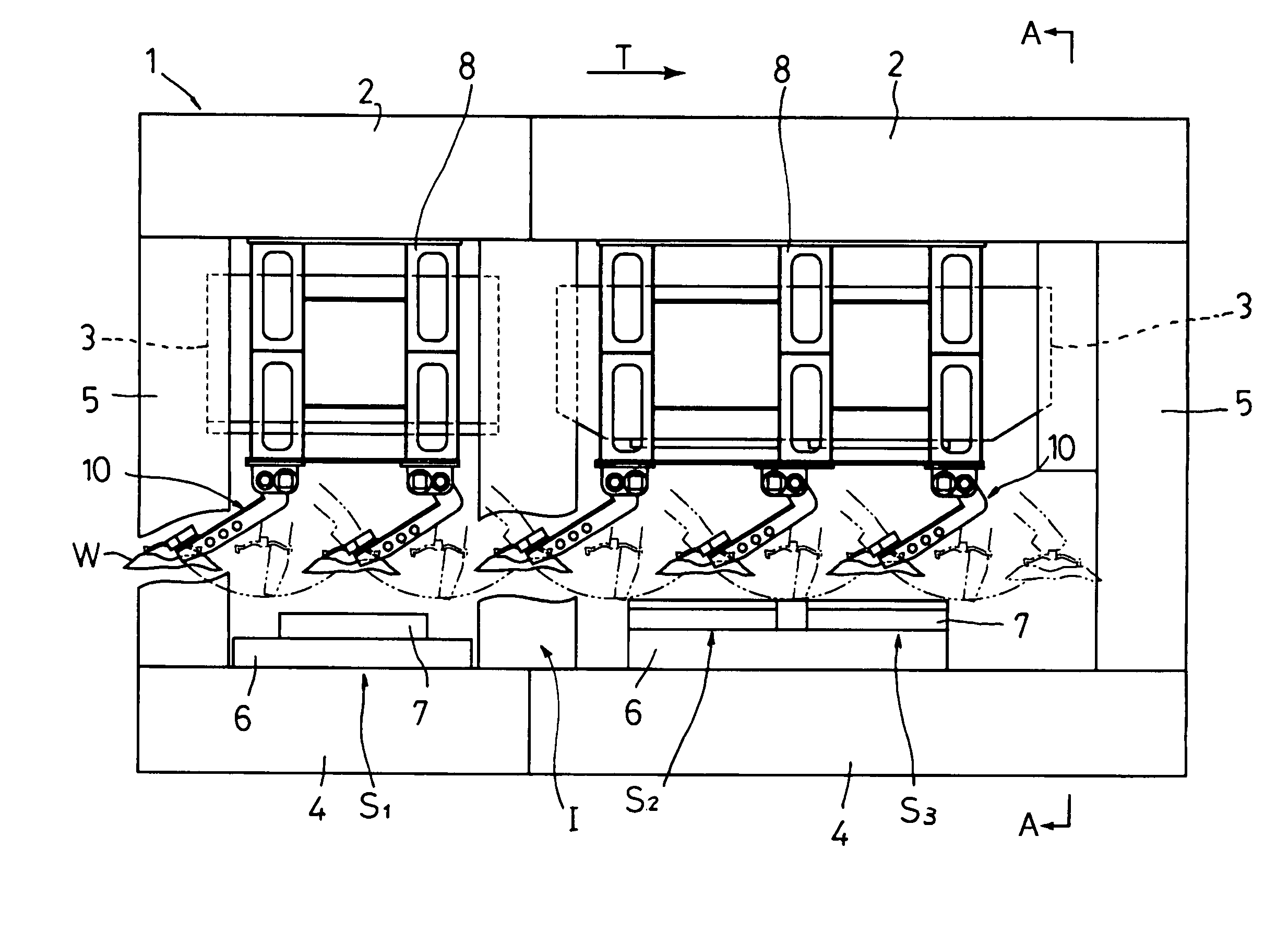Workpiece conveyor for press line
a technology of conveyors and workpieces, applied in the direction of manufacturing tools, transportation and packaging, packaging, etc., can solve the problems of increasing the weight of lift beams, poor visibility, and the weight of the driving system, so as to achieve the effect of simplifying the structure, and increasing the degree of freedom
- Summary
- Abstract
- Description
- Claims
- Application Information
AI Technical Summary
Benefits of technology
Problems solved by technology
Method used
Image
Examples
first embodiment
[0062]FIG. 1 shows a general schematic front view of a transfer press according to a first embodiment of the invention. FIG. 2 shows an essential part side view taken along line A—A of FIG. 1.
[0063]A transfer press 1 according to the first embodiment has crowns 2, slides 3 and beds 4. In the transfer press 1, the crowns 2, uprights 5 and the beds 4 are integrated by tie rods (not shown) and press molding is performed using an upper die (not shown) attached to the underside of each slide 3 and a lower die 7 mounted on a moving bolster 6 opposed to the slide 3. Desired work stations S1, S2, S3 and an idle station I1 are provided in compliance with a process specification, and a desired number of workpiece conveyors 10 (five workpiece conveyors in this embodiment) are disposed according to the operation for carrying a workpiece W into or out of the processing position of each of the work stations S1, S2, S3 and idle station I1. Herein, the driving mechanism of the slide 3, which is omi...
second embodiment
[0074]Next, reference is made to FIGS. 5 and 6 to describe a workpiece conveyor according to a second embodiment of the invention. FIG. 5 shows an essential part sectional and front view illustrating the structure and operation of the workpiece conveyor according to the second embodiment. FIGS. 6(a) and 6(b) show an essential part sectional and plan view and an essential part sectional and side view, respectively, of the workpiece conveyor according to the second embodiment. Similarly to the workpiece conveyor 10 of the first embodiment, a workpiece conveyor 30 of the second embodiment is bilaterally symmetrical with respect to the workpiece conveying direction T, and therefore only the right part of the workpiece conveyor 30 is illustrated in FIGS. 5 and 6 for the sake of simplicity. In the second embodiment, the parts similar to those of the first embodiment are designated by the same reference numerals as given to the first embodiment and a detailed description thereof will be om...
third embodiment
[0081]FIGS. 7(a) and 7(b) show a front view and a view taken in the direction of arrow C of FIG. 7(a), respectively, which illustrate the structure and operation of a workpiece conveyor according to a third embodiment of the invention. In FIGS. 7(a), 7(b), the parts similar to those of the foregoing embodiments are designated by the same reference numerals as given to the foregoing embodiments.
[0082]A workpiece conveyor 50 according to the third embodiment has, at one side, a first arm (rocking element) 52 the proximal end of which is pivotally attached to a clevis-type bracket 51 secured to the underside of the supporting column structural member 8; and a second arm (corresponding to “at least one link” of the invention) 53 the proximal end of which is pivotally attached to the distal end of the first arm 52. The first arm 52 is oscillating-driven relative to the bracket 51 by activation of the servo motor 20 mounted on the bracket 51 through the reduction gear 19, whereas the seco...
PUM
| Property | Measurement | Unit |
|---|---|---|
| degree of freedom | aaaaa | aaaaa |
| vertical distance | aaaaa | aaaaa |
| distance | aaaaa | aaaaa |
Abstract
Description
Claims
Application Information
 Login to View More
Login to View More - R&D
- Intellectual Property
- Life Sciences
- Materials
- Tech Scout
- Unparalleled Data Quality
- Higher Quality Content
- 60% Fewer Hallucinations
Browse by: Latest US Patents, China's latest patents, Technical Efficacy Thesaurus, Application Domain, Technology Topic, Popular Technical Reports.
© 2025 PatSnap. All rights reserved.Legal|Privacy policy|Modern Slavery Act Transparency Statement|Sitemap|About US| Contact US: help@patsnap.com



